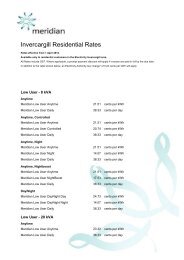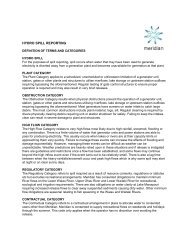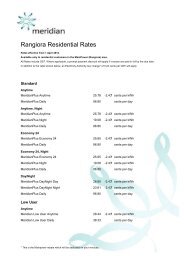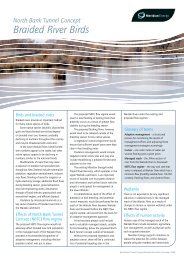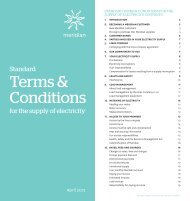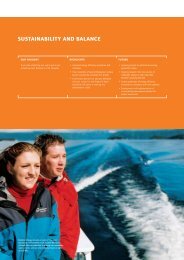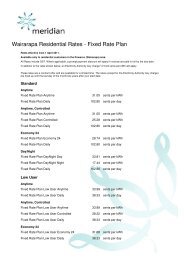Meridian Annual Report - Meridian Energy
Meridian Annual Report - Meridian Energy
Meridian Annual Report - Meridian Energy
You also want an ePaper? Increase the reach of your titles
YUMPU automatically turns print PDFs into web optimized ePapers that Google loves.
6<br />
Our Operations<br />
<strong>Meridian</strong> is New Zealand’s largest electricity generator, supplying<br />
electricity to over 180,000 residential, business and rural customers<br />
throughout the country. Our electricity is generated from renewable<br />
resources. Currently we operate nine hydro stations in the South Island,<br />
two wind farms, one in the Manawatu in the lower North Island and<br />
one in Mossburn in Southland and a wind turbine in Wellington.<br />
Assets<br />
Te Āpiti Wind Farm<br />
Te Āpiti is <strong>Meridian</strong>’s first New Zealand<br />
wind farm and the first wind farm to supply<br />
electricity into New Zealand’s national grid.<br />
Its 55 turbines have a generation capacity<br />
of 90MW – enough to power around 32,000<br />
average sized households.<br />
Wellington Wind Turbine<br />
New Zealand’s first viable, commercial wind<br />
turbine, it was installed in 1993 and has a<br />
maximum capacity of 0.23MW – enough to<br />
power around 80 average households.<br />
White Hill Wind Farm<br />
White Hill in Southland is the first wind<br />
farm in the South Island. It was officially<br />
opened on 8 June 2007. Its 29 turbines have<br />
a generation capacity of 58MW – enough<br />
electricity to power around 20,000 average<br />
households.<br />
Manapouri<br />
New Zealand’s largest hydro power station,<br />
Manapouri was voted New Zealand’s<br />
greatest engineering achievement in 2006.<br />
The station is underground, 200 metres<br />
below the West Arm of Lake Manapouri.<br />
Commissioned in 1972, Manapouri’s<br />
generation capacity of 840MW (operational<br />
limit is 710MW) is enough to power around<br />
half a million average households.<br />
Waitaki Hydro Scheme<br />
The Waitaki hydro scheme consists of eight<br />
power stations in the Mackenzie basin and<br />
Waitaki Valley, from Lake Tekapo to Lake<br />
Waitaki, all operated from a control centre<br />
in Twizel. The first station (Waitaki) was<br />
commissioned in 1935, and the last (Ohau C)<br />
in 1985.<br />
Tekapo A Commissioned in 1951, Tekapo A<br />
was the second power station in the Waitaki<br />
Hydro Scheme. Its generation capacity of<br />
25MW is enough to power around 15,000<br />
average households.<br />
Tekapo B Commissioned in 1977, the Tekapo B<br />
power station is essentially an island in the<br />
middle of Lake Pukaki, connected to shore<br />
by a 75-metre-long bridge. Its generation<br />
capacity of 160MW is enough to power<br />
around 83,000 average households.<br />
Ohau A Ohau A is located on the man-made<br />
Ohau canal. Water from Ohau A passes into<br />
Lake Ruataniwha, which is the site of an<br />
international rowing course. Commissioned<br />
in 1979/80, Ohau A’s generation capacity of<br />
264MW is enough to power around 110,000<br />
average households.<br />
Ohau B and C Twin stations Ohau B and C<br />
were the last power stations in the Waitaki<br />
hydro scheme to be commissioned, in 1984<br />
and 1985 respectively. Their combined<br />
generation capacity of 424MW is enough to<br />
power around 185,000 average households.<br />
Benmore When Benmore power station<br />
was commissioned in 1965 it was the largest<br />
dam in the Southern Hemisphere. Benmore’s<br />
generation capacity of 540MW is enough to<br />
power around 215,000 average households.<br />
Aviemore Aviemore power station<br />
was commissioned in 1968. It houses<br />
New Zealand’s first artificial trout spawning<br />
stream, allowing fish to reach spawning<br />
grounds above the dam. Its generation<br />
capacity of 220MW is enough to power<br />
around 90,000 average households.<br />
Waitaki The first power station on the<br />
Waitaki river was built with picks and shovels<br />
during the 1930s Depression. Commissioned<br />
in 1935, Waitaki’s generation capacity of<br />
90MW is enough to power around 47,000<br />
average households.



